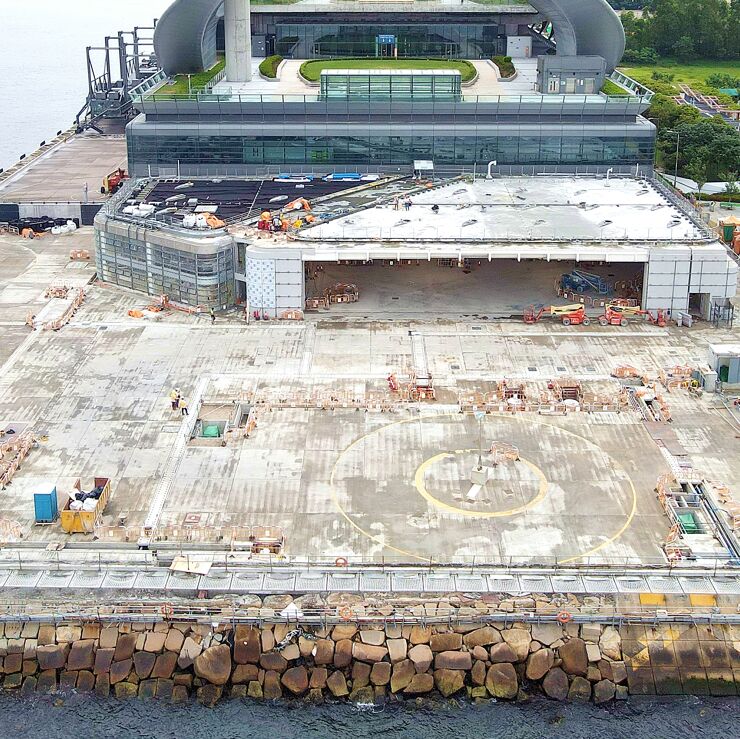
By Simon Fullalove
The Hong Kong government has used NEC to procure a new state-of-the-art helicopter base at the end of the former Kai Tak airport runway in Kowloon.
The Civil Engineering and Development Department (CEDD) of The Government of the Hong Kong Special Administrative Region let the work to contractor Chun Wo Construction and Engineering Company Limited in December 2018 under an NEC3 Engineering and Construction Contract (ECC) Option B (priced contract with bill of quantities). Ove Arup and Partners Hong Kong Limited was appointed NEC project manager and supervisor.
The HK$323 million (£30 million) project provided facilities for a new Kai Tak Division of the Government Flying Service, which undertakes search, rescue and aviation support from its headquarters at Hong Kong International airport on Chek Lap Kok island. It provides a forward operating base for the eastern part of Hong Kong and has removed the development height restriction at Tung Chung New Town development beside the airport.
Situated next to the Kai Tak Cruise Terminal and Kai Tak Runway Park, the 7,400 m2 scheme included construction of: a two-storey-plus-basement command and control centre and helicopter hangar; an apron area for helicopter take‐off, landing and parking; and supporting infrastructure including water supply, drainage, sewerage, fuel supply and storage. It was a true multi-disciplinary project involving architectural design, civil and structural engineering, building works, electrical and mechanical engineering, aeronautical navigation and communications systems, fitting-out and landscaping. The contract was successfully completed on time and budget in mid-2021.
Managing Risks
According to CEDD East Development Office chief engineer Mak King Ming, ‘We adopted NEC as it provides a better environment for contracting parties to manage project and construction risks, and to deal with issues in a collaborative manner for the benefit of the whole project. Following the NEC requirement to work in a, “spirit of mutual trust and co-operation,” all project team members built a good partnering relationship during construction, with joint efforts to resolve site problems and develop ideas.’
He says that in line with NEC processes, continuous communication was maintained between the client, contractor, project manager and supervisor through regular meetings such as risk reduction, programme review, site progress and senior management reviews. ‘In particular, the NEC early warning process for early identification of risks was one of key elements for the smooth running of the project. Through regular risk reduction meetings, the project team explored alternatives to eliminate or minimise the possible impacts.’
For instance, Mak says it was identified in a risk reduction meeting that when the deep excavation for building basement commenced, overall progress would be affected due to limited space for temporary storage of excavated material for reuse as backfill. ‘In view of the tight schedule, CEDD took proactive action to acquire additional site areas from other government departments to improve logistics and safety, even though it was the contractor’s responsibility to plan its working sequence and method. This allowed more concurrent activities at the original site area, with more space and thus improved progress and safety.’
Effective Communication
He says that effective communication was another key element to build trust and teamwork. ‘Bi‐weekly workshop meetings were conducted amongst project team members in a collaborative manner from an early stage. This ensured that foreseeable problems were resolved prior to commencing site activities, wherever possible.’
Following the onset of the Covid-19 pandemic in March 2020, Mak says direct dialogue was maintained via video conferences, including with overseas sub‐contractors and suppliers. ‘Maintaining a good relationship with external stakeholders was critical. The project team also maintained close and regular communication with all stakeholders, including the Kai Tak Cruise Terminal operator, Kai Tak Runway Park manager, other relevant authorities and the general public. In doing so, misunderstandings and unnecessary complaints and interruption to the works were avoided.’
He says NEC-inspired collaboration between senior management also played a key role in resolving contractual and technical issues. ‘The senior management from the project team worked collaboratively on discussing the works progress, site safety and financial matters. An example was the joint effort by senior management to resolve the problem of open‐cut sewerage works being obstructed by uncharted utilities. They swiftly agreed on an alternative trenchless construction method through an NEC compensation event.’
Mak concludes, ‘With concerted efforts by the project team on early risk identification and effective cooperation, the project was successfully completed on programme and budget. It was voted Outstanding in the 2019 Occupational Health Awards, received a Merit Award in the 26th Considerate Contractors Site Award Scheme, and a Merit Award in the 2020 Innovative Safety Initiative Awards.’
Benefits of Using NEC
- NEC provided an environment for the contracting parties to manage project and construction risks, and to deal with the issues in a collaborative manner for the benefit of the whole project.
- NEC requirement to work in a, ‘spirit of mutual trust and co-operation,’ ensured all project team members built a good partnering relationship during construction, with joint efforts to resolve site problems and develop ideas.
- NEC contract management processes ensured continuous communication was maintained between the client, contractor, project manager and supervisor through regular meetings such as risk reduction, programme review, site progress and senior management reviews.
- NEC early warning process for early identification of risks was vital to the smooth running of the project, with regular risk reduction meetings enabling the project team to explore alternatives to eliminate or minimise the possible impacts.




